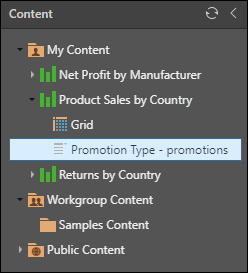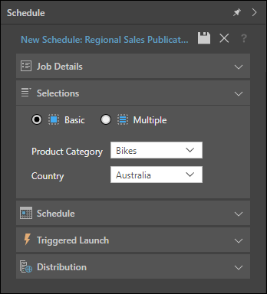Publication Slicers and Interactions
Adding a slicer will open the Interaction Manager, which is an interface used to connect slicers to publication components (visualizations, dynamic assets, and sections). The interface handles the wiring up of the data elements even if they are from different data models, in different databases, or on different servers.
Once all the artifacts, dynamic text and sections have been added to the template, users can elect to attach one or more slices. This can produce hundreds and thousands of published report variations.
You can add a slicer to your publication in two ways:
Add Slicers from Discover
To add filter or parameter slicers that have been saved as part of a query in Discover, find the relevant slicer in the Content folders.

Drag the slicer onto the canvas. This action will open the Interaction Manager.

Drop the slicer onto the Interaction Manager, and find the slicer in the From column. Add interactions from the slicer by selecting the checkbox next the relevant visuals.

When ready, minimize the Interaction Manager.
Note that your slicer will not be visible from the page view within the Publish app. You must configure additional slicer preferences when scheduling your Publication. See Share and Schedule a Publication for details.
Add a New Slicer in Publish
Use this option to build slicers on the fly, or to filter your publication by elements from other data models.
STEP 1
Click the New Slicer button from the Home ribbon to open the New Slicer dialog.

STEP 2
From the Choose Model panel, select the required server, database, and data model.
STEP 3
Select the relevant hierarchy from the Select Hierarchies panel.
STEP 4
In Set Default Visualization, name your slicer and choose a slicer Type. To specify elements, hierarchy levels, sets, or parameters, switch to Advanced.

STEP 5
Open the Interaction Manager from the Home ribbon. From the dialog, check the relevant boxes to add slicer interactions to visuals.

STEP 6
Save changes to your report, and configure slicer settings from the Selections tab in the Schedule dialog. See Share and Schedule a Publication for details

STEP 7
To edit or delete a slicer, open the Interaction Manager. Right click on the slicer heading and select Delete to remove the slicer, or Slicer Settings to change the title of the slicer.
